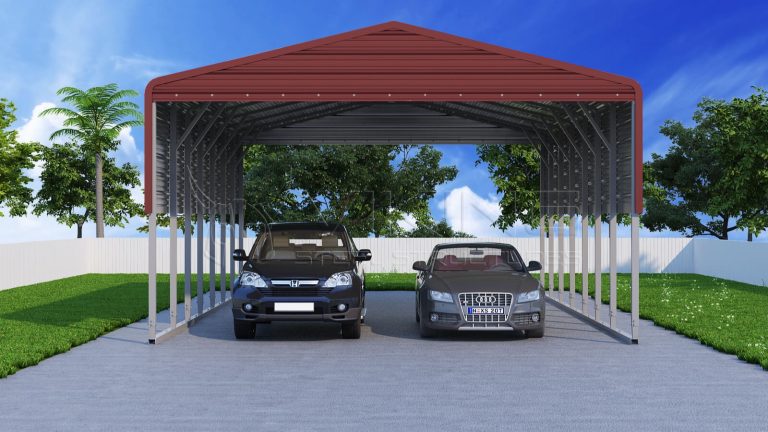Why Ventilation Systems Matter in Metal Buildings

Imagine walking into a steel garage on a summer afternoon. You can feel the air is heavy because heat is trapped inside the building. Often, condensation drips from the ceiling and makes your life difficult with the structure. If you have not stored anything in the building, it may not be a significant issue, but if you have, humidity can spoil the items and even accelerate the corrosion process.
In this situation, storing expensive equipment, housing animals, or working inside that same building every day becomes difficult and almost impossible in the summer. So, ventilation may not be the flashiest feature of a metal building, but it is the quiet force that decides whether your investment thrives or struggles.
Let’s break down why ventilation matters so much, the systems available, and how to choose the right one for your steel building.
What Is a Ventilation System?
A ventilation system is like the breathing system of a building. It lets fresh air come in and pushes stale, hot, or damp air out. In metal buildings, this is extra important because steel traps heat and can collect moisture on its surfaces. Without ventilation, the inside of a building can become too hot, too humid, or even unsafe for the animals you want to nurture, the tools you need in different seasons, and your workers. A ventilation system, whether it’s simple roof vents or powered fans, keeps the air moving so the building stays cooler, drier, and healthier.
The Science Behind Ventilation in Metal Buildings
Ventilation is simply the controlled movement of air in and out of a building. But in steel structures, its role is bigger than just moving air. It’s also about protecting everything inside and ensuring a comfortable environment for them.
We all know that metal naturally conducts heat. On hot days, the roof and walls absorb the sun’s energy, creating a greenhouse effect inside. Without proper airflow, the temperature spikes and makes the space unbearable and unsafe for tools, vehicles, or livestock. Moisture is another enemy. In unventilated spaces, warm air collides with cooler surfaces, such as steel panels, leading to condensation. This water buildup promotes rust, weakens insulation, and can even lead to mold growth in stored goods.
So, ventilation is not just comfort; it affects structural integrity. It helps:
- Release trapped heat.
- Carry away excess moisture.
- Keep the air fresh for people and animals.
- Protect the steel from corrosion and premature wear.
Key Benefits of Proper Ventilation
Let’s explore the key advantages of taking ventilation seriously during buying a steel structure.
- Ventilation prevents your barn or garage from turning into an oven in summer. A well-ventilated space stays cooler without overloading your HVAC system.
- By moving air, ventilation reduces the accumulation of water droplets on steel panels. This process saves your items and entire structure from rust, paint damage, and weakened frames.
- Be it horses, hay, cars, or commercial goods, everything lasts longer when air circulates. For animals, it ensures breathable air; for equipment, it prevents damp-related issues.
- A dry, stable environment means fewer repairs and replacements. With the help of a proper ventilation system, you can save on long-term maintenance costs.
- By cutting down heat buildup, you rely less on artificial cooling. That means smaller energy bills and lower environmental impact. It’s one of the crucial eco-friendly benefits of a steel building.
Types of Ventilation Systems for Metal Buildings
But the question is, which type of ventilation fits your prefabricated building? You need to have a basic understanding of which ventilation system performs which function. Here are some widely used systems.
Ridge Vents
- How Ridge Vents Work: They are placed along the peak of the roof to let hot air naturally escape from the building. As warm air rises, it finds its way out, creating a natural airflow cycle.
- Cost Range: The cost can vary, but it typically ranges from $2 to $4 per linear foot. It’s affordable for large-span structures.
- Best Suited For: Ridge vents are ideal for large barns, warehouses, and clear-span garages where internal airflow is crucial.
- Why It Matters: They are low-cost and highly effective in reducing heat and humidity without the need for mechanical systems.
Turbine Vents
- How They Work: These dome-like vents spin with the wind, pulling air out of the building. They can be passive (wind-driven) or active (powered).
- Cost Range: $50–$100 per unit, plus installation.
- Best Suited For: This type of ventilation is suitable for small to medium-sized steel garages or workshops.
- Pros & Cons: This type of system is low-cost and effective in windy areas, but less useful in calm regions.
Louvers and Gable Vents
- How They Work: Installed on side walls or gables, they allow fresh air in while pushing stale air out.
- Cost Range: $40–$200, depending on size and material.
- Best Suited For: Install it for your steel livestock shelters, storage units, sheds, or smaller buildings.
- Why Use Them: Great for cross-ventilation. They are simple, durable, and often used as a first step in improving airflow.
Exhaust Fans
- How They Work: Powered fans pull air out and push fresh air in. They are controlled manually or automatically with sensors.
- Cost Range: $300–$800 per fan + ongoing electricity costs.
- Best Suited For: They are best suited for industrial kitchens, livestock barns, or commercial facilities with high heat or strong odors.
- Pros & Cons: They offer reliable airflow regardless of weather, but they add energy costs.
Cupolas with Vents
- How They Work: Traditionally decorative, cupolas now double as ventilation systems. They sit atop the roof and allow rising hot air to escape.
- Cost Range: $500–$2,000, depending on design and size.
- Best Suited For: Install them in your vertical roof metal barns, horse stables, or farm buildings where aesthetics are also important.
- Why It Matters: Cupolas with vents combine style with function, improving both curb appeal and comfort.
Doors and Windows
- How They Work: It may sound simple, but windows and doors are natural ventilation tools. When opened, they let fresh air flow in while pushing out hot or stale air. The airflow improves even more when doors and windows are positioned opposite each other, creating a cross-breeze.
- Cost Range: The cost varies depending on size, material, and glazing. A basic metal building window can cost around $150–$500, while a heavy-duty insulated door may range from $500 to $2,000.
- Best Suited For: Windows and doors work well in workshops, garages, residential-style steel buildings, and farm structures where people or animals spend time.
- Why It Matters: They do more than just provide entry and light; they boost air circulation, control moisture, and make the building more comfortable without extra energy use. When combined with other ventilation systems, windows and doors improve both function and livability.
How Ventilation Affects Different Metal Buildings
Some structures require basic ventilation systems, while others need advanced ventilation systems. It’s because the design of a building affects the type of ventilation. If you are also planning to install a metal building, here is how ventilation can affect your building.
Steel Garages
A steel garage often shelters more than just vehicles. It may hold power tools, electronics, or even seasonal equipment. Without proper airflow, trapped moisture leads to condensation on your cars and tools. This can ruin your car paint, short-circuit electronics, and cause rust to spread silently. With ridge vents, louvers, or exhaust fans in place, garages stay dry and cooler, protecting valuable assets. Skipping ventilation here is like letting slow, invisible damage creep into your investments.
Horse Barns
Horses are sensitive animals, and their barns need more than walls and a roof. Without ventilation, ammonia from urine and manure builds up in a steel barn. There is no need to say how irritating it is. It affects the lungs and increases the risk of respiratory diseases. Stale, humid air also makes stalls smell unbearable. Ridge vents, cupolas, or gable vents create a steady flow of fresh air, reducing odors and promoting healthier horses. A poorly ventilated barn isn’t just uncomfortable; it can directly harm the animals it was built to protect.
Commercial Warehouses
In large commercial spaces, heat and humidity can quickly spiral out of control. Without ventilation, stored goods such as food, electronics, or textiles may spoil, warp, or lose their value. It can increase the maintenance cost and overall steel warehouse prices over time. Workers also struggle in stifling heat, leading to fatigue and lower productivity. Installing ridge vents, turbine vents, or industrial exhaust fans helps regulate the climate, safeguarding both products and employees.
Metal Workshops
Workshops are packed with tools, machinery, and sometimes paint or chemicals. Moisture in an unventilated building accelerates rust and damages sensitive machines. The air can also become heavy with fumes from paints or welding, creating a dangerous work environment. Ventilation systems, such as fans and louvers, maintain breathable air while extending the life of costly equipment. Without it, you would spend more money replacing tools than actually using them.
Costs vs. Savings of Ventilation Systems
At first, installing ventilation might look like an added expense. But when you compare long-term savings, the math is simple:
- Lower Maintenance: No rust repairs or paint touch-ups every year.
- Energy Bills Drop: Reduced need for cooling systems saves money monthly.
- Protecting Investments: Whether livestock or machinery, avoiding damage saves thousands.
For example, a $500 ridge vent installation in a barn could save over $ 5,000 in equipment damage or structural repairs over 10 years.
How to Choose the Right Ventilation System for Your Building?
Selecting the right ventilation system may sound tricky, but once you match it with your climate, building size, and purpose, the decision becomes much clearer. Here are the key things to focus on:
Climate Considerations:
- Humid areas → Pair ridge vents with louvers to let moisture escape.
- Hot/dry → Go for lighter roofing colors plus turbine vents for better airflow.
- Cold/snowy → Rely on mechanical systems like exhaust fans for steady, controlled circulation.
Size of Building:
- Larger barns or warehouses perform better with ridge vents or exhaust fans.
- Smaller sheds or storage units can rely on louvers, windows, or doors to maintain air movement.
Purpose:
- Livestock barns → Cupolas, exhaust fans, and windows ensure fresh, breathable air for animals.
- Storage → Ridge vents + insulated doors help regulate temperature.
- Workshops → A mix of vents, windows, and insulation keeps machines and tools dry and safe.
Budget:
- Passive systems, such as ridge vents or louvers, have a low upfront cost but rely on favorable weather conditions to be effective.
- Exhaust fans or powered systems cost more but guarantee performance regardless of the climate.
- Adding well-placed windows and doors is one of the most affordable ways to increase airflow and reduce the need for costly mechanical systems.
Breath Life into Your Steel Building With Us
Without ventilation, even the strongest steel will struggle against condensation, heat, and wear. Proper airflow means healthier animals, safer tools, lower bills, and a longer-lasting structure. Therefore, when installing a prefabricated building, ensure that it has a proper ventilation system in place. Viking Steel Structures can help you with it, and everything you need to make a steel building perfect. We design structures with the right ventilation and high-quality steel components, and install them impeccably, leveraging our decade of experience.
You can explore our wide range of steel buildings available in various shapes and sizes, and contact us at 877-801-3263 if you want to inquire about any building.

Looking for a metal building that fits your needs?

